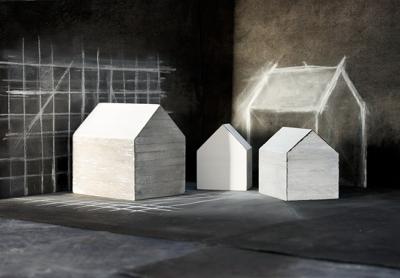Myers Finds Links in Disparate Chains

January is a surprising month on the South Fork. While the crowds die down and the only bluster is the wind (and snow), there are often quiet but significant efforts to draw full-time residents and weekenders away from their hearths and out onto the scene again.
In addition to other off-season exhibitions, there is now in Bridgehampton some new life bubbling to the surface at the Kathryn Markel Gallery. Each year Ms. Markel closes down operations during the winter, but makes her space available to independent curators and artist collectives. For the month of January, the gallery will be home to Folioeast, a mostly online assemblage of East End artists represented by Coco Myers, an East Hampton native, who after years in the media world came back several years ago to live here with her family.
She will present two shows. The first, which opened on Jan. 7 but due to that day’s snowstorm will be celebrated with a reception on Saturday, is a blend of abstraction and figuration in several mediums. Judging by the choices of the artwork on view through Sunday and a preview of the upcoming installation, it is a well-edited mix of some of the more innovative artists working here.
Markel is a small gallery, and the works are small as well, with 11 artists represented on every section of white space available. The artists offer a mix of abstraction and figuration, some, like Toby Haynes, presenting naturalism, and others, such as Dan Welden and Will Ryan, non-objective art. Jane Martin offers a bit of both. All have a strong presence, and the installation works to bracket the more exuberant works with the more reserved and cerebral.
Margaret Garrett is represented by two colorful works on paper. “Lean” is a collage of yellow paper, in a kind of floral motif, pasted on a royal-blue ground. “Tuning Fields” is dominated by red tones, and looks both completely abstract and vaguely representative of a field of tulips.
Nearby, Janet Jennings offers two watercolors of stacked rectangular planes in faded translucent tones. There are also two small canvases, at first glance apparently abstract and then the purified essence of landscapes, the overall silvery hues of which are scored by acid tones of green and orange.
On another wall, Mr. Welden and Mary Ellen Bartley balance each other, with the cool linear precision of the books she photographs from their tops and sides setting off his spare but relatively more colorful mixed-media works.
Ms. Bartley’s eye for the abstract in the photographed image is shared by Carolyn Conrad and Bastienne Schmidt. Ms. Conrad’s photos and watercolor of her familiar abstracted barn structures show a movement away from her earlier versions in moody and rich colored backgrounds. These are stark and spare in tones of gray and white. Ms. Schmidt’s abstract geometric photographs in subtle tones tap into a similar urge.
Mr. Ryan maintains the appetite for abstraction in his graphic watercolors, which add a pop of color and playfulness to the mix. Similarly, Mr. Haynes’s realistic depictions of cows and Barbara Thomas’s homage to trees are richly colored and highlighted in varying shades of blue. Upstairs, a few selections from her series “The Day” are on view with Ms. Martin’s “Artifacts,” mixed-media works on paper. The “Artifacts” hint at meaning. One could be a stage set, another looks like the prow of a ship, but the intent and the actual subject is obscured. They beguile with their striking ornamentation and air of mystery.
Additional works by Mr. Welden and Ms. Jennings round out the room.
The only sculptor in the crowd, Sarah Jaffe Turnbull, is represented by a group of metallic glazed table pieces that are ceramic but hint at bronze. The forms of “Accord” and “Solo” suggest vessels, but the fissures and seams that don’t meet would never hold contents. “Rosetta” could be an assemblage of geometric shapes, but it is suggestive of other objects; musical instruments perhaps. She is displayed with some of Ms. Martin’s mostly naturalistic video stills and her abstract works in other mediums.
This show, which will be open Saturday and Sunday and can be also viewed by appointment, is part one of a two-part exhibition. Part two, opening on Jan. 20, will feature works by 11 artists: Roisin Bateman, Philippe Cheng, Christine Matthai, Perry Burns, Denise Gale, Francine Fleischer, Mark Webber, Maeve D’Arcy, Rosario Varela, Sue Heatley, and Janice Stanton.
Although a final checklist is still in formation, Ms. Myers offered a preview of parts of the second exhibition, including Ms. Stanton’s collages, which incorporate groupings of seemingly recognizable objects and more idiosyncratic creations. Mr. Cheng will show his photographic abstractions, which lately are darker and bluer than the images in his recent book. Mr. Webber’s small minimalist sculptures and Christine Matthai’s word-based constructions will be on display as well.
